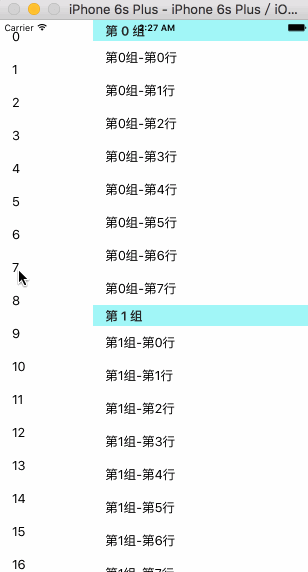一、先来看看要实现的效果图

二、小解析,可以先看看后面的!

三、实现 tableView联动 主要分两种状况
1、点击 左侧 cell 让右侧 tableView 滚到对应位置
2、滑动 右侧 tableView 让左侧 tableView 滚到对应位置
1.先实现简单的:点击 左侧 cell 让右侧 tableView 滚到对应位置
//MARK: - 点击 cell 的代理方法 - (void)tableView:(UITableView *)tableView didSelectRowAtIndexPath:(NSIndexPath *)indexPath { // 判断是否为 左侧 的 tableView if (tableView == self.leftTableView) { // 计算出 右侧 tableView 将要 滚动的 位置 NSIndexPath *moveToIndexPath = [NSIndexPath indexPathForRow:0 inSection:indexPath.row]; // 将右侧 tableView 移动到指定位置 [self.rightTableView selectRowAtIndexPath:moveToIndexPath animated:YES scrollPosition:UITableViewScrollPositionTop]; // 取消选中效果 [self.rightTableView deselectRowAtIndexPath:moveToIndexPath animated:YES]; } }
左侧 按钮点击的联动 搞定!
2.滑动 右侧 tableView 让左侧 tableView 滚到对应位置
[self.rightTableView indexPathsForVisibleRows] 返回 所有显示在界面的 cell 的 indexPath
//MARK: - 一个方法就能搞定 右边滑动时跟左边的联动 - (void)scrollViewDidScroll:(UIScrollView *)scrollView { // 如果是 左侧的 tableView 直接return if (scrollView == self.leftTableView) return; // 取出显示在 视图 且最靠上 的 cell 的 indexPath NSIndexPath *topHeaderViewIndexpath = [[self.rightTableView indexPathsForVisibleRows] firstObject]; // 左侧 talbelView 移动到的位置 indexPath NSIndexPath *moveToIndexpath = [NSIndexPath indexPathForRow:topHeaderViewIndexpath.section inSection:0]; // 移动 左侧 tableView 到 指定 indexPath 居中显示 [self.leftTableView selectRowAtIndexPath:moveToIndexpath animated:YES scrollPosition:UITableViewScrollPositionMiddle]; }
第二步 右侧 滑动 跟左侧 的联动 搞定! 对的 就是这么简单!!!
四、警告
看到别人通过这两个方法判断!!! 勿用!!!
会导致 tableView 的联动 不准确
#pragma mark - UITableViewDelegate 代理方法 - - (void)tableView:(UITableView *)tableView willDisplayHeaderView:(UIView *)view forSection:(NSInteger)section { // // headerView 将要显示 // 这两个方法都不准确 } - (void)tableView:(UITableView *)tableView didEndDisplayingHeaderView:(UIView *)view forSection:(NSInteger)section { // // headerView 已经显示 // 这两个方法都不准确 }
五、以下是所有示例代码
// // ViewController.m // 左右双tableView联动 // // Created by 阿酷 on 16/8/20. // Copyright © 2016年 AkuApp. All rights reserved. // #import "ViewController.h" #define leftTableWidth [UIScreen mainScreen].bounds.size.width * 0.3 #define rightTableWidth [UIScreen mainScreen].bounds.size.width * 0.7 #define ScreenWidth [UIScreen mainScreen].bounds.size.width #define ScreenHeight [UIScreen mainScreen].bounds.size.height #define leftCellIdentifier @"leftCellIdentifier" #define rightCellIdentifier @"rightCellIdentifier" @interface ViewController () <UITableViewDataSource, UITableViewDelegate> @property (nonatomic, weak) UITableView *leftTableView; @property (nonatomic, weak) UITableView *rightTableView; @end @implementation ViewController - (void)viewDidLoad { [super viewDidLoad]; [self.view addSubview:self.leftTableView]; [self.view addSubview:self.rightTableView]; } #pragma mark - tableView 数据源代理方法 - - (NSInteger)tableView:(UITableView *)tableView numberOfRowsInSection:(NSInteger)section { if (tableView == self.leftTableView) return 40; return 8; } - (NSInteger)numberOfSectionsInTableView:(UITableView *)tableView { if (tableView == self.leftTableView) return 1; return 40; } - (UITableViewCell *)tableView:(UITableView *)tableView cellForRowAtIndexPath:(NSIndexPath *)indexPath { UITableViewCell *cell; // 左边的 view if (tableView == self.leftTableView) { cell = [tableView dequeueReusableCellWithIdentifier:leftCellIdentifier forIndexPath:indexPath]; cell.textLabel.text = [NSString stringWithFormat:@"%ld", indexPath.row]; // 右边的 view } else { cell = [tableView dequeueReusableCellWithIdentifier:rightCellIdentifier forIndexPath:indexPath]; cell.textLabel.text = [NSString stringWithFormat:@"第%ld组-第%ld行", indexPath.section, indexPath.row]; } return cell; } - (NSString *)tableView:(UITableView *)tableView titleForHeaderInSection:(NSInteger)section { if (tableView == self.rightTableView) return [NSString stringWithFormat:@"第 %ld 组", section]; return nil; } #pragma mark - UITableViewDelegate 代理方法 - //- (void)tableView:(UITableView *)tableView didEndDisplayingHeaderView:(UIView *)view forSection:(NSInteger)section { // // 这两个方法都不准确 //} // //- (void)tableView:(UITableView *)tableView willDisplayHeaderView:(UIView *)view forSection:(NSInteger)section { // // 这两个方法都不准确 //} //MARK: - 一个方法就能搞定 右边滑动时跟左边的联动 - (void)scrollViewDidScroll:(UIScrollView *)scrollView { // 如果是 左侧的 tableView 直接return if (scrollView == self.leftTableView) return; // 取出显示在 视图 且最靠上 的 cell 的 indexPath NSIndexPath *topHeaderViewIndexpath = [[self.rightTableView indexPathsForVisibleRows] firstObject]; // 左侧 talbelView 移动的 indexPath NSIndexPath *moveToIndexpath = [NSIndexPath indexPathForRow:topHeaderViewIndexpath.section inSection:0]; // 移动 左侧 tableView 到 指定 indexPath 居中显示 [self.leftTableView selectRowAtIndexPath:moveToIndexpath animated:YES scrollPosition:UITableViewScrollPositionMiddle]; } //MARK: - 点击 cell 的代理方法 - (void)tableView:(UITableView *)tableView didSelectRowAtIndexPath:(NSIndexPath *)indexPath { // 选中 左侧 的 tableView if (tableView == self.leftTableView) { NSIndexPath *moveToIndexPath = [NSIndexPath indexPathForRow:0 inSection:indexPath.row]; // 将右侧 tableView 移动到指定位置 [self.rightTableView selectRowAtIndexPath:moveToIndexPath animated:YES scrollPosition:UITableViewScrollPositionTop]; // 取消选中效果 [self.rightTableView deselectRowAtIndexPath:moveToIndexPath animated:YES]; } } #pragma mark - 懒加载 tableView - // MARK: - 左边的 tableView - (UITableView *)leftTableView { if (!_leftTableView) { UITableView *tableView = [[UITableView alloc] initWithFrame:CGRectMake(0, 0, leftTableWidth, ScreenHeight)]; [self.view addSubview:tableView]; _leftTableView = tableView; tableView.dataSource = self; tableView.delegate = self; [tableView registerClass:[UITableViewCell class] forCellReuseIdentifier:leftCellIdentifier]; tableView.backgroundColor = [UIColor redColor]; tableView.tableFooterView = [[UIView alloc] init]; } return _leftTableView; } // MARK: - 右边的 tableView - (UITableView *)rightTableView { if (!_rightTableView) { UITableView *tableView = [[UITableView alloc] initWithFrame:CGRectMake(leftTableWidth, 0, rightTableWidth, ScreenHeight)]; [self.view addSubview:tableView]; _rightTableView = tableView; tableView.dataSource = self; tableView.delegate = self; [tableView registerClass:[UITableViewCell class] forCellReuseIdentifier:rightCellIdentifier]; tableView.backgroundColor = [UIColor cyanColor]; tableView.tableFooterView = [[UIView alloc] init]; } return _rightTableView; } @end
六、总结
IOS实现左右两个TableView联动效果的内容到这就结束了,这种的效果在我们平常的时候还是挺常见的,感兴趣的朋友们可以自己动手操作起来,希望对大家的学习工作能有所帮助。
【IOS实现左右两个TableView联动效果】相关文章:
